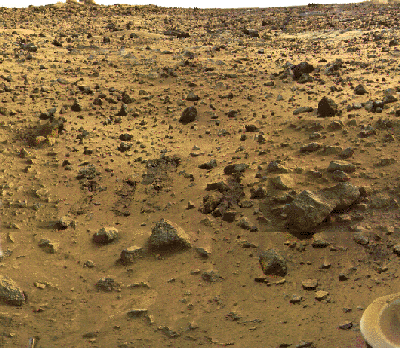The new finding counters the previous explanation of the evenly spaced arrangement of small rocks on Mars. That explanation suggested the rocks were picked up and carried downwind by high-speed winds thought to have occurred on Mars.
Images taken by the Mars Exploration Rover Spirit show small rocks regularly spaced about 2 to 3 inches (5 to 7 centimeters) apart on the plains between Lahontan Crater and the Columbia Hills.
Although Mars is a windy planet, it would be difficult for the wind to carry small rocks, which range in size from a United States quarter to a softball, said Jon D. Pelletier, associate professor of geosciences at The University of Arizona in Tucson.
Pelletier and his colleagues suggest that wind blows sand away from the front of a rock, creating a pit, and then deposits that sand behind the rock, creating a hill. The rock then rolls forward into the pit, moving into the wind, he said. As long as the wind continues to blow, the process is repeated and the rocks move forward. This explanation does not require extreme winds, Pelletier said. “You get this happening 5, 10, 20 times then you start to really move these things around. They can move many times their diameter.”
The process is nearly the same with a cluster of rocks. However, with a cluster of rocks, those in the front of the group shield those in the middle or on the edges from the wind, Pelletier said. Because the middle and outer rocks are not directly hit by the wind, the wind creates pits to the sides of those rocks. Therefore, they roll to the side, not directly into the wind, and the cluster begins to spread out.
Pelletier, Andrew L. Leier of the University of Calgary in Alberta, Canada, and James R. Steidtmann of the University of Wyoming in Laramie report their findings in the paper, “Wind-Driven Reorganization of Coarse Clasts on the Surface of Mars.”
When Leier was a graduate student at the University of Alberta, he told Pelletier about an experiment on the upwind migration of rocks that Steidtmann, Leier’s thesis advisor, had conducted. Steidtmann had studied upwind migration about 30 years ago. He used a wind tunnel to see how pebbles on sand moved in the wind. Steidtmann’s research showed that the rocks moved upwind and that over time, a regular pattern emerged.
Some time later, while attending a lecture that showed pictures of uniformly organized rocks on Mars, Pelletier recalled his conversations with Leier about Steidtmann’s experiments – and it all came together.
To investigate the regular patterns of the rocks on Mars, Pelletier combined three standard numerical computer models. The first modeled air flow, the second modeled erosion and deposition of sand, and the third modeled the rocks’ movement, he said.
“We can model it on the computer to try to get a better sense of what’s actually happening and to provide another sort of documentation or justification for the idea,” he said.
Pelletier was the first to combine the three standard models and apply them to this new problem.
He also conducted what is known as a Monte Carlo simulation, which applies his combination numerical model over and over to a random pattern of rocks to see how the rocks ultimately end up. Pelletier ran the simulation 1,000 times. The rocks ended up into a regular pattern 90 percent of the time, he said.
As an independent verification, he also compared the pattern predicted by the numerical model to the distances between each rock and its nearest neighbor in the Mars images. The patterns of the martian rocks matched what the model predicted.
Pelletier said upwind migration of rocks also occurs on Earth.
Co-author Leier said, “Something as seemingly mundane as the distribution of rocks on a sandy, wind-blown surface can actually be used to tell us a lot about how wind-related processes operate on a place as familiar as Earth and as alien as Mars.” However, because plants and animals can alter wind patterns and rearrange rocks, it is much more difficult to study this process on Earth, Pelletier said.
Pelletier plans to apply the same numerical models to larger features on Mars such as sand dunes and wind-sculpted valleys and ridges called “yardangs.” He said understanding the climate history of other planets and where those climates went awry can help in understanding our own climate system.










